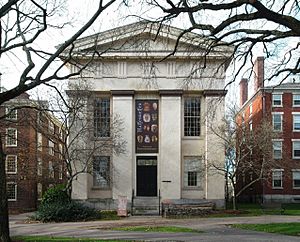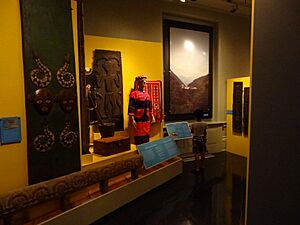Haffenreffer Museum of Anthropology facts for kids

Haffenreffer Museum of Anthropology, housed in Manning Hall.
|
|
| Lua error in Module:Location_map at line 420: attempt to index field 'wikibase' (a nil value). | |
| Established | 1955 |
|---|---|
| Location |
|
| Type | Teaching museum |
| Owner | Brown University |
The Haffenreffer Museum of Anthropology is a special museum at Brown University. It's a place where students and teachers learn about different cultures. The museum has a cool gallery in Manning Hall in Providence, Rhode Island. It's about 2,000 square feet! There's also a research center in Bristol, Rhode Island, where they keep many of their collections.
Contents
About the Museum
How the Museum Started
The Haffenreffer Museum began with the private collection of a person named Rudolf F. Haffenreffer. He was an industrialist, which means he owned big businesses. In 1917, he bought a large estate in Bristol called Mount Hope Grant. This land was once home to Metacomet, a leader of the Wampanoag people.
Rudolf Haffenreffer found many old objects on his property. He also collected more items during his trips across the Western United States. In 1928, he built a museum to keep his collection. He called it the Haffenreffer Museum of the American Indian.
After he passed away in 1954, his family gave his collection and the estate to Brown University. A person named J. Louis Giddings became the first director. Under his leadership, the museum started collecting items from other parts of the world. This included artifacts from the Arctic, Africa, and the Pacific.
In 1995, Brown University thought about moving the museum to Downtown Providence. They even bought some buildings for this plan. However, they later sold those buildings in 2009 and decided not to move the museum there.
In 2006, the Haffenreffer Museum opened a gallery in Manning Hall. This building is right on Brown University's main campus. In 2019, the museum announced a new plan. They wanted to move all their collections from Bristol to a single place in Providence. This new spot would be close to the Brown campus. A grant from the Andrew W. Mellon Foundation helped them with this big move.
What the Museum Does
The Haffenreffer Museum of Anthropology is a teaching museum for Brown University. It helps people think creatively and critically about different cultures. It does this by exploring objects from around the world.
The museum gives students and teachers chances to work with its collections. They also work with the public. They teach through objects and special programs. These programs happen in classrooms, in the CultureLab, and in exhibitions at Manning Hall. They also take place at the Collections Research Center.
Museum Exhibitions
The museum often changes its exhibitions in the Manning Hall gallery. This gallery is in the middle of Brown University's campus. These exhibits show off the museum's collections from all over the world. They also highlight the work of Brown University's teachers, staff, and students.
The museum also has many public events. These include lectures, performances, festivals, and activities for schools. They offer a wide range of programs for people of all ages.
Learning Programs
The museum has many educational programs for Brown University students. These programs are often held in the CultureLab, which is part of the Manning Gallery. The museum also offers special group programs for local schools. Plus, they have many public lectures for everyone to enjoy.
Museum Collections
Amazing Artifacts
The museum has about one million items in its collections! It has a very strong collection of items from Native North America. But it also has important items from other places. These include Latin America, Africa, the Middle East, and Asia.
Here are some examples of what they have:
- About 900,000 old objects found by researchers in Alaska. These are from lands managed by the National Park Service.
- About 70,000 old objects and 6,000 cultural items from other parts of North America.
- About 2,500 old objects and 3,000 cultural items from South and Central America.
- About 40 old objects and 3,000 cultural items from Africa. Some of these were made by artists today.
- About 400 old objects and 400 cultural items from Europe.
- About 1,100 cultural items from Asia.
- About 1,500 cultural items from Oceania.
Image Collections
The Haffenreffer Museum Research Collections Center has a large collection of photographs. Besides pictures of the items in their collection, they have photos from the museum's founder. They also have the Spinden collection, which has images of Central and South America. Plus, they have field photographs that came with other collections. The Center's library has about 10,000 books!
Here are some special parts of their image collection:
- The Herbert Spinden Photographic Archive: This has over 20,000 images and documents. They are about Central American archaeology and cultures from the early 1900s. Many pictures show important old sites that have changed or been destroyed since then.
- The Kensinger Collection: This has over 5,000 photographs and notes. They are from anthropologist Ken Kensinger's research with the Cashinahua people of Peru. He did this research from 1960 to 1996.
- The Conti Collection: This has over 3,000 photographs from the late 1950s to the early 1970s. They were taken by a photographer from Rhode Island named Gino Conti. Most of them are from the Hopi, Apache, and Navaho reservations, and from Mexico.
- Photographs of ancient rock carvings (petroglyphs) from the Southwest. These were taken by Salvatore Mancini. Many of them are in a museum book called Terra Incognita.
- Artworks like lithographs and serigraphs. These are by and about the Inuit, the Ainu, Plains Indians, and many others.
See also
- John Whipple Potter Jenks


